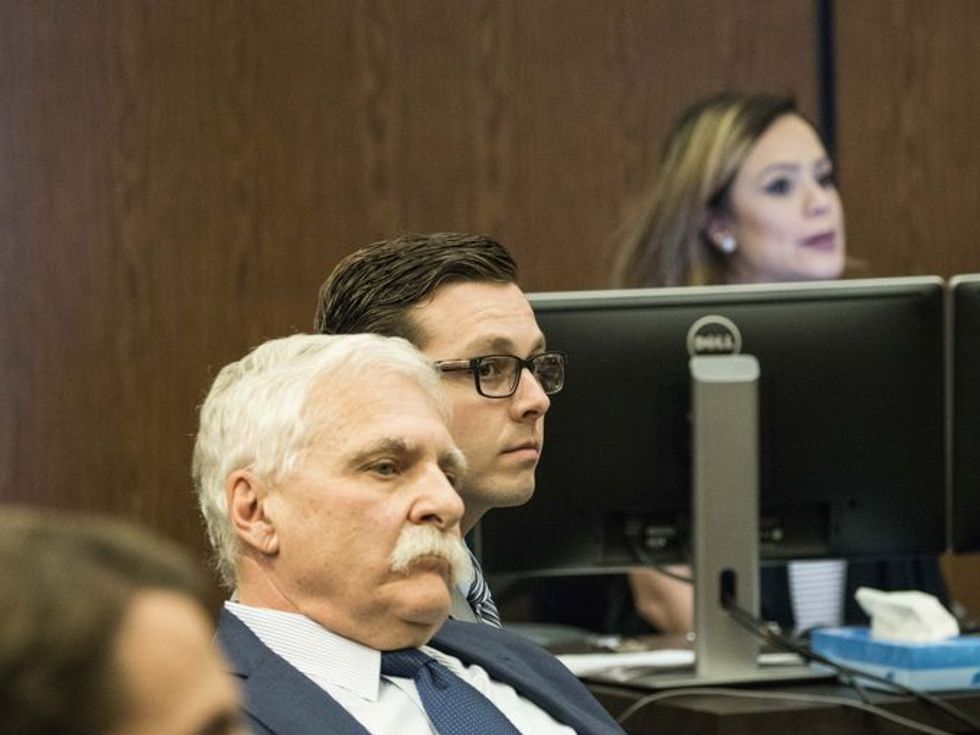Brailsford (right) and his attorney, Michael Piccarreta (left), sit in the Maricopa County Court on the day of Brailsford’s acquittal (Photo Credit: AzCentral.com).
This Thursday, former Mesa Police Department officer Philip “Mitch” Brailsford, 27, was acquitted of second-degree murder charges in connection with Daniel Shaver’s death. In graphic video footage shot by Brailsford’s body cam on January 18th, 2016, Shaver is seen crawling on the floor and begging for his life shortly before being fatally shot by Brailsford’s AR-15 rifle.
On the night of Shaver’s death, Brailsford, Sergeant Charles Langley, and other officers were responding to a call about someone pointing a rifle from a 5th story La Quinta Inn window. Shaver, 26, was present at the hotel that evening drinking alcohol with Luis Nuñez and Monique Portillo. Nuñez left Shaver’s hotel room before police arrived because he reportedly became uncomfortable when Shaver began playing with a pellet gun he used for pest control duty. Portillo remained in the room with Shaver.
Brailsford’s body cam footage shows Shaver and Portillo exiting their La Quinta hotel room in compliance with orders shortly after the police arrived on the scene. After being given a series of instructions including getting down on the ground, putting his hands behind his head, and crossing his legs while crawling toward the officers, Shaver is seen reaching back toward his right hip just before being fatally shot by Brailsford.
Brailsford had been charged with the unlawful use of police force in an investigation led by the Maricopa County Attorney's Office in March 2016. However, the eight-member Maricopa County Superior Court jury reached a different verdict on December 7th after deliberating for six hours between two days.
Brailsford's attorney, Michael Piccarreta, brought in police-training experts who took the stand and helped convince the jury that Brailsford's use of fatal police force was justified. Brailsford also took the stand and testified that he would have “done the same thing" if the situation had happened the exact same way all over again. Brailsford reportedly believed he had rightfully followed his academy training to use force if he believed his life, or the life of another person, is in danger.
In consequence of the court proceedings, the jury found Brailsford not guilty of second-degree murder and of reckless (involuntary) manslaughter.
Brailsford has been acquitted.
Insufficiency of the Law
The issue, of course, isn’t whether the Maricopa Court adequately interpreted the law. The issue is that the law is insufficient when it comes to evaluating the lawful use of fatal police force.
The Maricopa judge and jury partnered in this case to determine two things: whether Brailsford intentionally killed Shaver without planning to do so in advance (i.e., second-degree murder) or whether he unlawfully but unintentionally killed Shaver without malicious forethought (i.e., reckless/involuntary manslaughter). Their not guilty verdict on both of these counts rests primarily on a principle affirmed by the 1989 Supreme Court case of Graham v. Connor: When it is claimed that police have used excessive force against a citizen, said claim must be reviewed using the “objective reasonableness” standard embedded within the Fourth Amendment, regardless of the officers’ subjective intent or motivation.
[Related: U.S. laws protect police, while endangering civilians]
It makes sense, then, that intent was inconsequential to Brailsford’s case. The use of fatal force by police isn’t evaluated for intent, it’s evaluated for rationale. This means that if an attorney can prove to a jury that premises A through C rationally lend to an officer’s decision to use fatal force, said officer’s actions are lawful regardless of the aims he or she held at the time of the incident in question.
Because of this legal insufficiency, the claim that an officer feared for his or her life before deciding to use fatal force holds up in court more often than not. Officers are able to effectively convince the court that their decision to use fatal force logically follows from premise A (i.e., “A police officer was engaged in the search and seizure of a citizen in accordance with his/her training and certification”), premise B (i.e., “A police officer feared for his or her life given the actions and/or disposition of the person being searched and/or seized”) and premise C (i.e., “It is lawful for an officer to use force during the search and seizure of a citizen if doing so is objectively reasonable given the facts to which the officer has access in the present moment and regardless of motive or intent”).
[Related: Purposes and Functions of Law]
The Officers' Actions and Intent
In the body cam footage, Sgt. Charles Langley is heard telling Shaver, “If you make a mistake, another mistake, there is a very severe possibility that you’re both going to get shot. Do you understand?”
Shaver attempts to respond to Langley but Langley interrupts with, “Shut up. I’m not here to be tactical and diplomatic with you. You listen. You obey.”
“If you move, we’re going to consider that a threat and we are going to deal with it and you may not survive it,” Langley continues.
Portillo is then seen crawling down the hallway toward the left side of the video frame. Shaver remains on the ground to the right with his hands on his head.
“Kay, young man, listen to my instructions and do not make a mistake," Langley shouts. He demands that Shaver gets into a kneeling position while keeping his legs crossed. But Shaver’s legs uncross as he pushes himself up, which leads to the officer shouting at him. “I said keep your legs crossed!"
One can imagine the distress Shaver experienced as the officers shouted with at least one rifle pointed his way. It was a game of “ Simon Says” that he was tragically losing.
“I’m sorry,” Shaver says, extending his hands toward his waist in front of him— perhaps a nervous gesture or fidget.
The officers begin yelling again.
"Your hands go back into the small of your back or down, we are going to shoot you. Do you understand?” Langley shouts.
Shaver pleads with the officers, "Please do not shoot me,” and stretches his hands straight up in the air. He begins sobbing and crawls down the hallway toward the officers.
As Shaver crawls, he reaches back with his right hand and Brailsford opens rapid fire.
Brailsford fatally shoots Shaver five times.
Langley’s demands of Shaver raise questions about the officers' intent. Was their main aim to search for and seize the rifle that allegedly protruded from a La Quinta window earlier that evening? Possibly. But there was another aim underlying Langley's communication to Shaver which irreversibly contaminated the scene: to subdue and dominate as an end, not as the means.
To hear an officer of the law explicitly admit that he is not performing his duty with the intent to be “tactical” or “diplomatic” is quite concerning. In that moment, Langley essentially admitted to Shaver that he had no plans to de-escalate the situation. He was there to command and be obeyed. Inciting Shaver’s submission and obedience was Langley's end goal— not the means by which he would confirm whether Shaver was, in fact, a viable suspect for the reported threat.
Additionally, Langley’s treatment of Shaver likely set the shared expectation among the other officers. As sergeant on the scene, Langley out-ranked ex-officer Brailsford by at least two levels of superiority. Consequently, he effectively used the influence latent in the power differential between him and the lower-ranking officers to indirectly communicate an emphasized aim.
According to the tone and content of Langley’s communication, the main aim of the evening was no longer the peaceful search and seizure of the alleged weapon. The new aim was the subjugation of Daniel Shaver by any means necessary.
It’s a wonder Langley himself wasn’t on trial given his influence on Brailsford’s behavior.
A Call to Put Officers’ Intent on Trial
Sgt. Langley and the rest of the officers on the scene had minutes worth of opportunity to approach Shaver and peacefully cuff his hands while they were extended in the air. They never did. Neither Brailsford nor Langley attempted to seize Shaver as he complied with commands to assume a non-threatening posture.
The officer’s actions speak volumes. It is doubtful that their intent was to search and seize. Otherwise, it’s expected that they would have done so.
But there is no room for the evaluation of the officers’ intent within the legal standards to which civilians are held. Brailsford’s acquittal proves that the intent of police when using fatal force is exempt from the legal examination process. If it reasonably follows that an officer believes he or she is in imminent danger, it is, therefore, legal for said officer to injure or even murder a civilian.
There is currently no protocol set by which we can ask why Brailsford was carrying an AR-15 rifle with the phrase “You’re F—ed” etched into the barrel. There is no standardized course of action to take in order to determine what cognitions prompted Brailsford to fire bullets into Shaver’s body so rapidly that the number of bullets expelled couldn’t be counted with the video footage running at regular speed.
Those details are largely considered irrelevant— even though they could offer insight into what Brailsford was most motivated by in the moments leading up to Shaver’s death.
As a result, officers like Brailsford can fulfill their duties and be as power-hungry as they want to be. They can have virtually no desire to protect and serve and no intent to peacefully search and seize a citizen for further investigation. They can care nothing about placing a suspect before a jury of their peers. They can even wield their weapon for the sole purpose of affirming an inward delusion of grandeur at the literal expense of others.
Their motives are classified files for which they answer to no one— not the courts, not fellow officers, not you, not me.
The intent of our police officers is shrouded in the upheld principles of cases like Graham v. Connor and Brailsford’s acquittal. And, as a result, our laws continue to ask the convenient questions. They ask about an officer’s assessment of danger. They ask about the objective reasonableness of said assessment.
But until our laws ask the tough questions about the intent our officers hold while engaging in the use of force, unarmed fatalities like that of Shaver will continue to occur with little chance of retribution.
With Justice lingering somewhere off in the distance— a taunting long shot, a receding target— civilians like you and me are left to ask the unanswerable:
How, if it should ever come to it, will I or someone I love know the difference between Officer Brailsford and Officer Do-Right?
***
What do you think? Should the Supreme Court ruling of Graham v. Connor continue to be upheld considering the use of fatal force by the police?
The best parts of our minds are shaped by dialogue— share your thoughts!
Originally published on Medium.com.




















